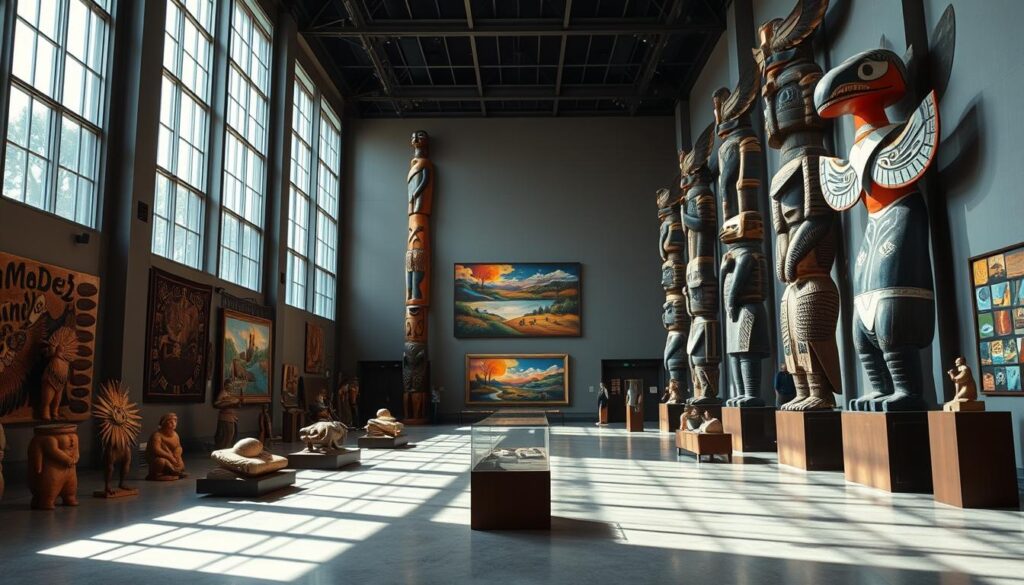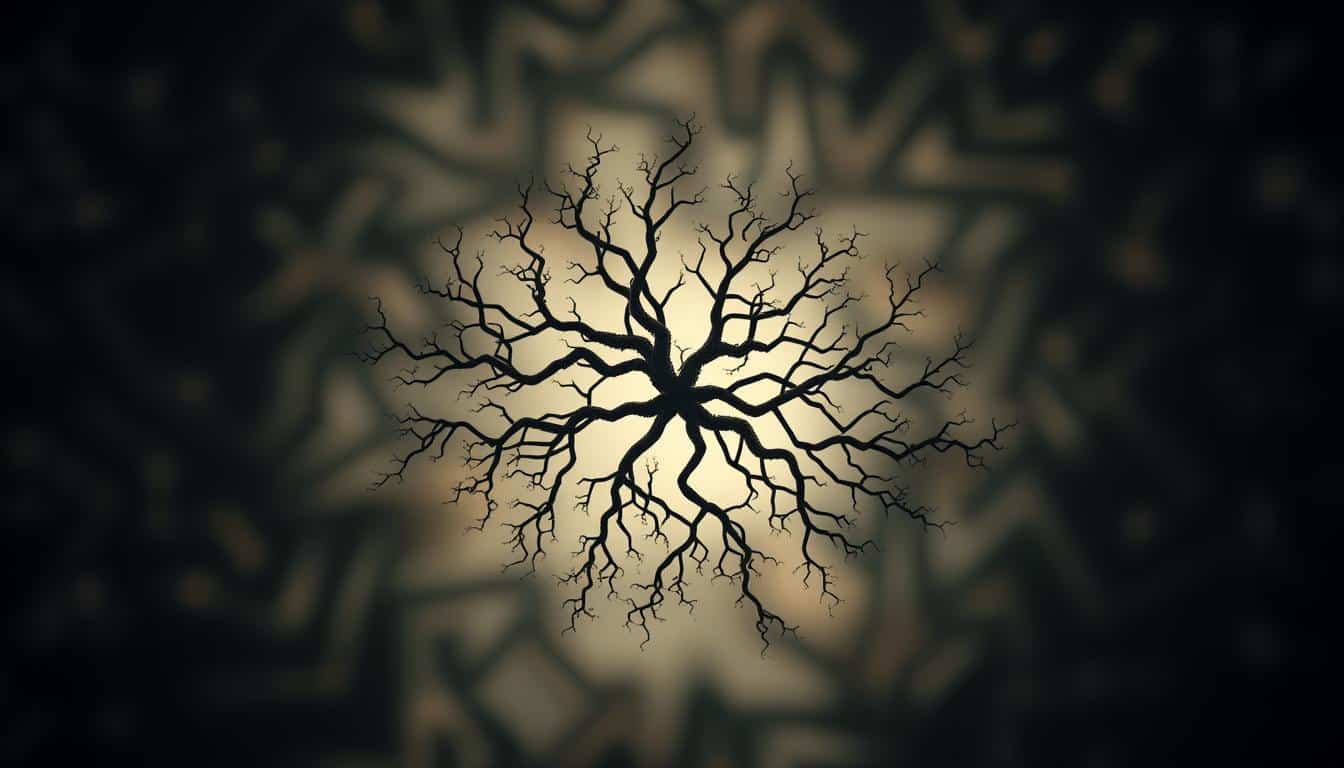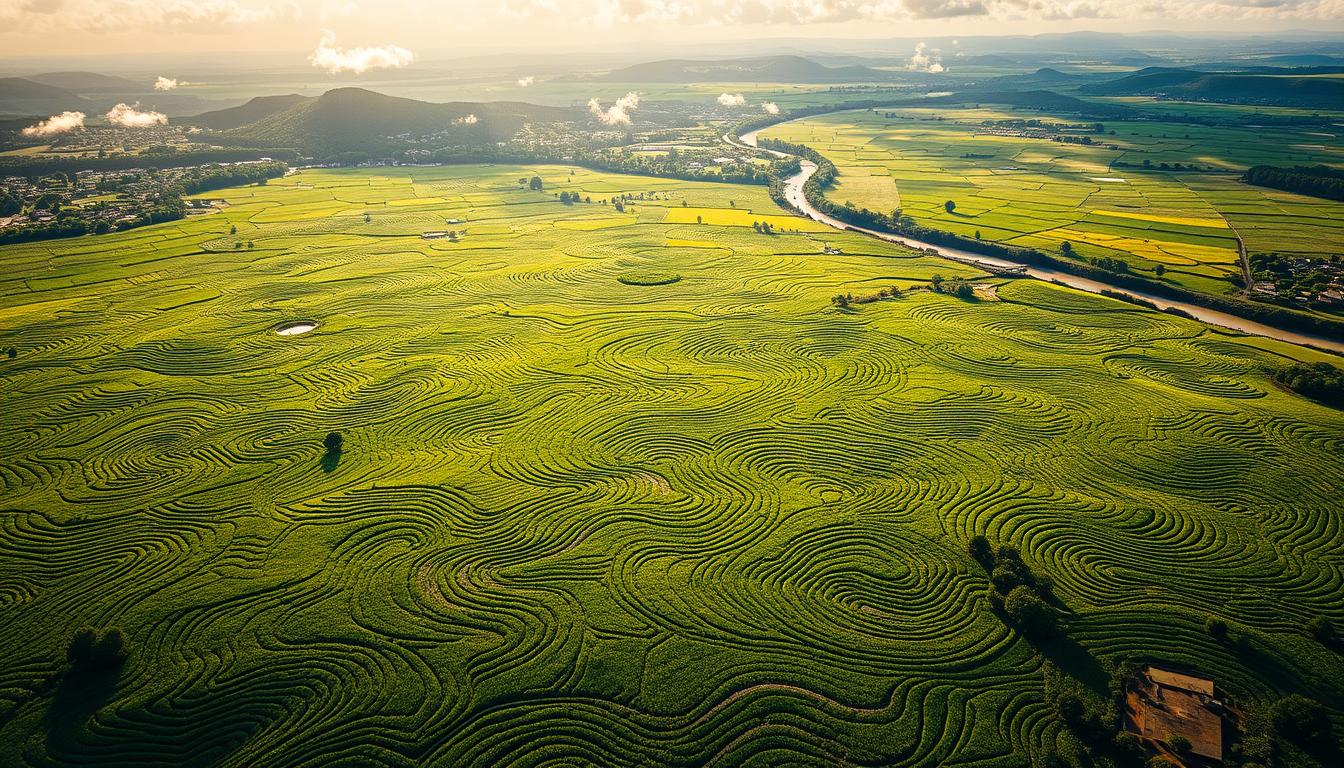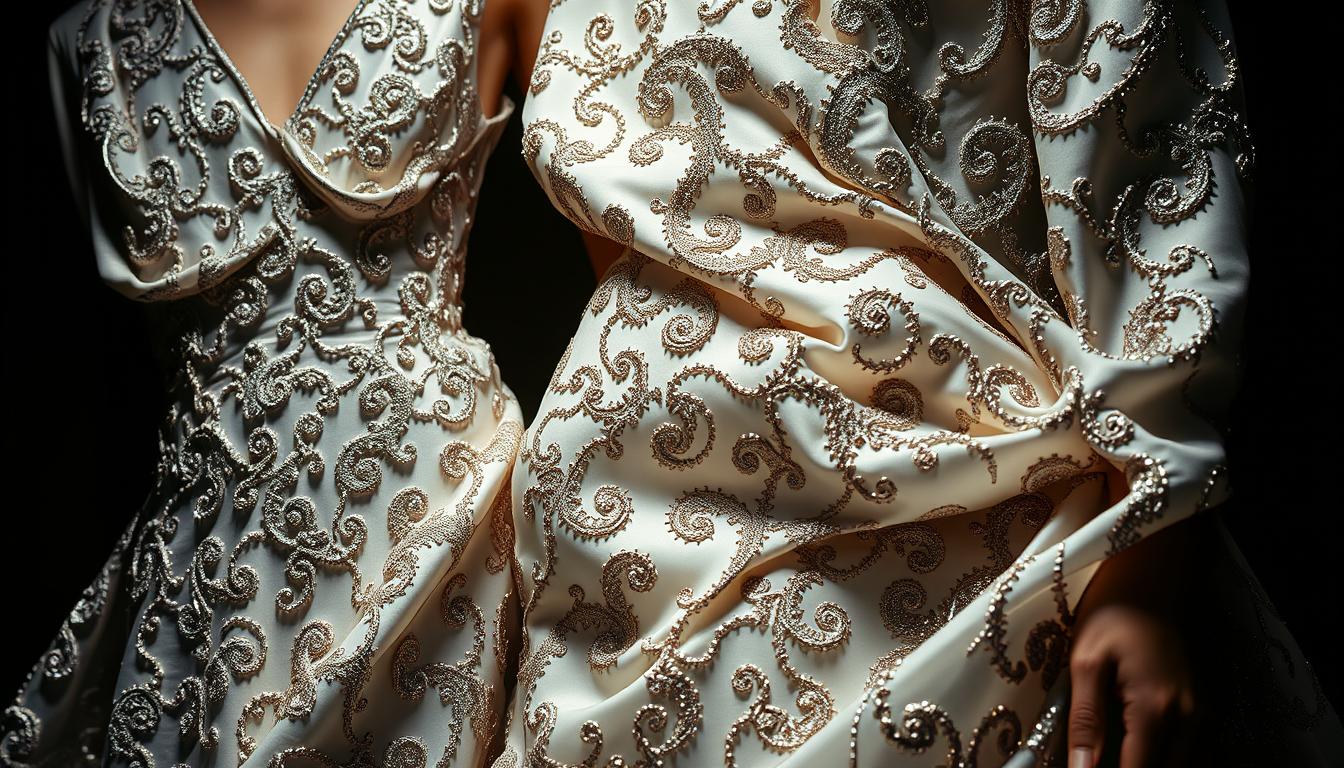Comparative galleries in Canadian Art are key in showing the link between Indigenous Art and Nature. These places let us see how Indigenous cultural heritage comes to life in art, revealing their bond with nature. They combine old practices and modern ways to deepen our understanding of Indigenous stories.
Through these explorations, we learn to value the art and the wider cultural stories it tells. This encourages us to respect and cherish these narratives.
The Historical Context of Indigenous Art in Canadian Galleries
The story of Indigenous art in Canadian galleries is a tale of being left out and then finally included. For ages, the art of First Nations people was not given much attention, especially not like European art. This neglect highlights the struggles of Indigenous artists trying to get their art seen.
In 2008, a big change happened when the Art Gallery of Ontario opened new halls. These halls put Indigenous art in the spotlight. The hiring of Gerald McMaster, the first Aboriginal curator, was a major move. It helped change the way people see and appreciate Indigenous art in Canada.
Since 1992, there has been a big push to show more Indigenous art in main exhibits. These efforts have changed how people think about and are interested in Indigenous art’s deep roots. Galleries all over Canada are now telling new stories. They are helping people understand the importance of Indigenous art in Canadian culture.

Understanding the Art/A artefact Binary in Museums
The Art A artefact Binary makes it hard to show Indigenous Art right in Museums. This view often makes Indigenous works seem less important, treating them as simple historical objects. Experts believe this not only overlooks Indigenous people’s heritage but also shows deep biases in cultural groups.
Understanding how art gets labeled is key. Mainstream art is usually just called ‘art.’ But Indigenous works get called ‘artefact,’ which makes them seem old, not relevant today. This label hides the true, lively nature of Indigenous arts.
Discussions in Cultural Critique are bringing up these problems. They say museums need to change how they think. By seeing things in a new way, they can truly show the value of Indigenous cultures. It’s about seeing their work as part of now, not just the past. Changing the Art A artefact Binary could make a big difference for Indigenous artists and their people.
The Role of Institutions in the Representation of First Nations Art
Art institutions play a key role in how First Nations art is seen in galleries. Places like the National Gallery of Canada and the Art Gallery of Ontario highlight indigenous art. They show the deep stories of First Nations communities. These places do more than just show art. They also start conversations about culture.
Important art shows have been set up over time. They challenge the old ways that often left out certain artworks. These shows let First Nations artists share their tales, views, and selves through art. Now, First Nations art is starting to cover more kinds of stories and voices.
Art places are also bringing indigenous voices into how they work and decide what art to show. They talk with First Nations artists and people to make sure the art is shown right and with respect. Working together like this helps art places and communities understand each other better. It makes the way we see First Nations art richer.
Key Exhibitions Impacting Indigenous Art Representation
Many Key Exhibitions have been crucial for displaying Indigenous Art Representation in North American galleries. “Land, Spirit, Power: First Nations,” hosted by the National Gallery of Canada, is one example. It was a groundbreaking event for Indigenous artists, bringing their art and stories to a wider audience.
Since the 1990s, more Cultural Events have shown the power of working together. These events often have artists and curators of Indigenous heritage leading the way. This ensures that the art displayed is true to its roots. Working together like this helps everyone understand Indigenous culture and art better.
Here are some other important Key Exhibitions:
- “Raven and the First Men” at the Museum of Anthropology in Vancouver
- “Sakahàn: International Indigenous Art” at the National Gallery of Canada
- “The Spirit of the Land” at various community galleries
These exhibitions do more than just fill gallery spaces. They start conversations about the value of Indigenous perspectives in today’s art scene. By sharing different stories, these events add to our cultural world. They also help lift the profile of Indigenous artists everywhere.
Examining First Nations Art as a Key Component of Canadian History
First Nations art is key to understanding Canadian history. It shows the rich culture of this diverse country. This art goes beyond just looking nice. It tells stories of resilience, deep spirituality, and a strong bond with the land.
By sharing their art, First Nations people also share their traditions. This exchange is important in Canadian history. It shows how indigenous cultures have mixed with wider society. Once ignored, these artworks now get the respect they deserve.
More people are seeing how important First Nations art is. It helps us understand the culture better. The art is full of meaning, like symbols and rituals that tell stories. These stories connect old and new generations.
Comparative Galleries: Nature, Algorithms, and Indigenous Art
Comparative galleries are leading the way in combining technology with indigenous art. This blending makes First Nations artwork more understandable and significant in our digital age. With technology’s role growing in galleries, how algorithms choose and showcase art becomes key. This influences how well indigenous artists get seen and appreciated.
Integrating Technology in Art Presentation
Technology is crucial in showing art in comparative galleries. It allows for new ways to display indigenous art, changing how we see traditional pieces. With interactive setups, people can dive deep into the cultural stories behind the artworks. This gives artists fresh ways to share their work and reach more people, deepening the conversation about their art.
The Influence of Algorithms on Art Criticism and Selection
Algorithms are reshaping art criticism and selection, deciding which artworks get noticed. In comparative galleries, these systems pick and suggest art based on what people like and current trends. While this could highlight First Nations artists, it also brings up concerns about selection criteria and biases in these automated systems. It’s important to understand algorithms’ effects to ensure fair representation of indigenous art today.
Artists as Cultural Advocates: Case Studies
Indigenous Artists have a crucial role in sharing cultural stories. They bridge old traditions with new ways of expression. Looking into the works of Meryl McMaster and Nico Williams, we see how they champion culture through art.
Meryl McMaster and Identity Exploration through Art
Meryl McMaster uses photography to mix identity with the land around us. She draws from her Indigenous background, prompting us to think about our connection to nature. Her photos often make us reflect on our inner selves.
McMaster’s dedication to identity lets her audience uncover deeper meanings in her pictures. This helps people appreciate Indigenous cultures more.
Nico Williams and the Celebration of Nature in Beadwork
Nico Williams’s beadwork shines a light on nature, community, and how we connect with our environment. His colorful works celebrate the Earth’s beauty and build a sense of unity in Indigenous communities. Through his art, Williams shows the importance of protecting our planet, using Indigenous wisdom.
Both artists prove that Indigenous art is key to sharing and understanding cultural values.
Environmental Concerns and Indigenous Perspectives in Art
Indigenous art is a strong voice for the environment. It shows how Indigenous people view their bond with nature. Artists share their spiritual respect for the earth through their work, highlighting the need to care for our planet.
Christi Belcourt is an artist who uses her talent to support sustainable living. She connects Indigenous culture with nature in her art. Her work encourages us to think about how important our land and resources are.
Art that includes Environmental Concerns with Indigenous views starts important conversations. It helps raise awareness and stresses the need to solve ecological problems. Through art, people feel a connection to the environment and learn the importance of protecting it.
Contemporary Practices of Indigenous Artists and Their Social Impact
Today’s Indigenous artists show their identity and culture in fresh ways. They challenge old views of Indigenous communities. By mixing old techniques with new materials, they make art that speaks to all kinds of people.
Their art has a big effect on society. It talks about important topics like caring for the earth, keeping cultures alive, and fairness for all. Art lets these artists share their world and what their communities go through.
Art places are starting to show more of this modern Indigenous art. This helps people understand and talk about big topics. These shows help change the way cultures are seen and make everyone feel welcome.
- Engagement with current social issues
- Redefinition of artistic boundaries
- Promotion of cultural narratives
Indigenous artists are sparking change with their new ideas. They help us see the value of their traditions in today’s world. This new kind of art doesn’t just make the art world better. It also changes society for the better.
The Evolution of Art Criticism Regarding Indigenous Works
Indigenous art’s role in criticism has changed greatly in recent years. In the past, it was often seen only as simple artifacts, not true art. This overlooked the deep cultural stories and value in these pieces.
Now, art critics and scholars see the beauty and cultural importance of Indigenous art. This change comes from:
- Influential critiques: Key figures in art spoke on the need to include Indigenous works in art history’s story.
- Cultural anthropology: Adding anthropological views helped talk about the deep meaning in Indigenous art beyond just its looks.
- Increased visibility: More Indigenous artists getting noticed made people rethink how we critique art.
Today’s art criticism is open to new views, respecting Indigenous works more. It values the cultural and artistic importance, leading to wider discussions in art spaces.
Public Reception of Indigenous Art in Modern Galleries
The way people see and enjoy Indigenous art in modern galleries matters a lot. This kind of art gets more attention now because of its deep stories and beauty. People now look at Indigenous art in new and exciting ways.
Lately, some art shows have really helped change how we see Indigenous art. They mix old ways with new ideas, making us curious about these stories and cultures. When we listen to what people think about the art, we learn what makes it special.
Modern galleries are changing by listening to what visitors think. They now include Indigenous art more, showing us different worldviews. This change sparks talks about history and identity. It makes people feel a stronger bond with the art, making our culture richer.
Conclusion
Looking at different galleries and Indigenous Art, we see how important it is to include and represent everyone in art today. Indigenous artists add much to our culture, often challenging old views and sharing their legacy. Their art talks about age-old traditions and today’s urgent issues about the environment and society.
Future trends show galleries using more technology to make Indigenous Art more accessible. This can help more people see and appreciate the art. It also means we might look at art in new ways. Plus, how we talk about art is changing, which helps us respect and understand Indigenous contributions better.
In wrapping up, it’s clear that galleries are important for bringing different kinds of art together. Staying dedicated to showing diverse voices and using new methods means we might connect with Indigenous Art more deeply. This ensures their stories and voices stay part of our culture.



